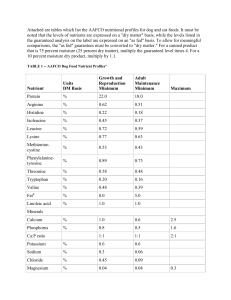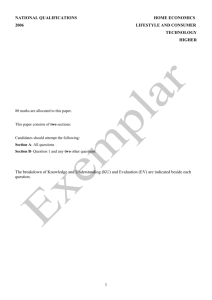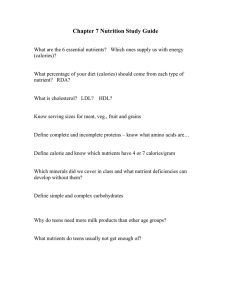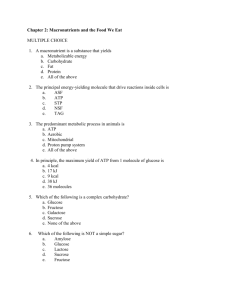Companion Animal Nutrition November 5, 2012 M.E. Persia
advertisement
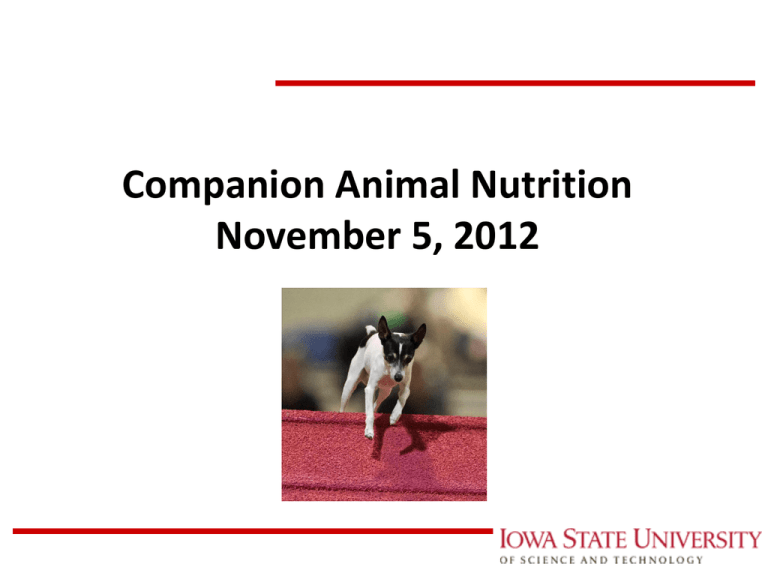
Companion Animal Nutrition November 5, 2012 M.E. Persia Iowa State University 4/16/2012 Carnivores Taxonomy • Domestic Cat – Phylum – Class – Order – Family – Genus – Species Animalia Mammalia Carnivora Felidae Felis catus Taxonomy • Domestic Dog – Phylum – Class – Order – Family – Genus – Species Animalia Mammalia Carnivora Canidae Canis (wolves, coyotes,jackels) (Vulpes = foxes) familiaris Domestication • Dog (15,000 years ago) – Genetic lineage • Fox-like canids (Arctic fox, red fox, raccoon dog, bat-eared fox) • South American canids (Crab-eating fox, maned wolf, bush dog) • Wolf-like canids (jackals, gray wolf, dogs, African hunting dog) • Cat (12 – 15,000 years ago) – 15,000 years ago (Mediterranean) – European wildcat (Felis sylvestris) 44 Essential Nutrients Carbohydrate Metabolism Protein Metabolism • Nutrigenomics – effects of nutrients on gene expression. • Known genomes • Nutrients influence gene expression • mRNA production (transcription) • mRNA processing • Protein production (translation) • Post-translational modifications Those directly impact the metabolic status of the animal. Fat Metabolism Urea Cycle How then did domestication alter nutrient needs of dogs and why are their needs different than wolves? The Petfood Industry Historical Timeline James Spratt = “Spratt Cakes” 1866 FH Bennett = Milk Bone 1908 20’s and 30’s Canned Oatmeal and Cornflakes Pelleting 40’s and 50’s World War II Rationing “Dog’s Need Meat” B12 deficiency 1954 1st Extrusion The Petfood Industry Historical Timeline 50’s and 60’s Began a societal shift toward Pets as family Companion animal research 70’s and 80’s Therapeutic and clinical diets 1990’s to present Holistic, natural, and organic diets Raw diets Nutrigenomics Petfood Myths • #1 pet-foods are not regulated – False – Heavily regulated and inspected – Agencies involved in Petfood industry • FDA, USDA, DHS, CDC, EPA, FTC, AAFCO – US Marshals • FDA audits companies for vendor documents • AAFCO (Association of American Feed Control Officials) – operates through state level bills with individual state health and agricultural agencies. • Recalls – melamine…what went wrong? Feeding Commercial Diets • Good news – – – – – Commercial diets must supply analytical compositions Regulated by FDA Nutrients must meet or exceed requirements (NRC, AAFCO) Monitored and recalled Big companies have some advantages • Bad news – – – – Not required to test regularly Quantity has nothing to do with quality Feed companies can change their formulas Requirements are published in a different unit than analyses on the product – Ingredient consistency AAFCO Statements • “…formulated to meet the nutritional levels established by the AAFCO dog (cat) food nutrient profiles for all life stages”. – Adequacy statement • “…intended for intermittent or supplemental feeding only” – Not an adequacy statement Processing • Extruded – 10 – 12% moisture; must contain significant carbohydrate. – Higher in starch and lower in fats and proteins than canned. • Canned – 70 – 80% moisture; contain higher concentrations of fat and protein, meats. – Retort process – heat and pressure cooking after the can has been filled and sealed. Doesn’t have to be just cans. • • • • • • Pelleted Semi-Moist Expanded Dehydrated Baked Canned Major Processing Considerations • Starch-Lipid complexes • Maillard reactions • Fat concentrations – majority of fat must be added/sprayed on after extrusion • Nutrient losses – Thiamin - > 70% is lost to heat Ingredients Used: Proteins • Protein Sources – Meats (turkey, chicken, etc…) • clean flesh and skin with or without bone - exclusive of feathers, heads, feet, and entrails. – Meat meals (chicken meal) • Dry, rendered (cooked down) product from clean flesh and skin… – By products (chicken by-products) • rendered, clean parts of the carcass of slaughtered chicken, such as heads, feet, viscera, etc… – By product meal (poultry by product meal) • ground, rendered, clean parts of the carcasses of slaughtered poultry… – Plant proteins • Soy bean meal • Corn gluten meal Proteins as Ingredients • Rendering reduces digestibility and protein quality of meats (more with poultry than other meats). • Species rendered products have higher protein quality than unidentified species (chicken meal is better than poultry meal) – although some differences are minor. Ingredients used: Carbs • Meals – (Corn) = entire corn kernel, finely ground • Grits, midds, mill run = – Are coarsely ground grains from which the bran and germ have been removed, usually screened to uniform particle size. • Flour – (Corn) Fine sized hard flinty portions of ground corn containing little or none of the bran or germ, highly processed. (wheat or rice flour). Understanding the Guaranteed Analysis Nutrient As Fed Basis Moisture, % Dry matter, % Protein, % Fat, % Fiber, % Protein: fat 78.0 8.0 (8/.22) = 5.0 1.0 Dry Matter 22.0 36.4 22.7 4.5 1.6 Understanding the Guaranteed Analysis Nutrient As Fed Basis Dry Matter Moisture, % Dry matter, % Protein, % Fat, % Fiber, % Ash Protein: fat 11.0 22.0 12.0 4.0 8.0 8.0 (22/.89) = 89.0 24.7 13.5 4.5 8.9 1.8 Some guidelines • High quality proteins as top 2 – Fresh meat should be followed by a meal (Chicken, chicken meal…) • Know the species • Fractions are OK – Watch for splitting, location on list • Select for a Protein to Fat ratio of 1.5 – 2.0 What is splitting • Venison meal, dried potatoes, potato starch, potato protein, pea protein, sunflower oil venison meal dried potato potato starch potato protein pea protein Where do you find nutrient requirements? • NRC for Domestic Cat (National Research Council) – National Academies • www.nap.edu = $265.50 • AAFCO (Association of American Feed Control Officials) – www. aafco.org = $50.00 NRC Presentation of Requirements • Requirements expressed relative to ME rather than DM. – ME determines the amount of food consumed. – If energy density of the diet changes, nutrients don’t change if expressed on an ME basis. – 4,000 Kcal per Kg. • Requirements based on body weight: – 15 Kg dog consuming 1,000 Kcal daily = maintenance – 5.5 Kg puppy consuming 1,000 Kcal daily = growth – 22 Kg lactating female with 8 puppies consuming 5,000 Kcal daily = lactation – Expressed as a factor of Metabolic Body Weight (MBW): • BWKg 0.75 for dogs • BWKg 0.67 for cats Why basing on ME is more ideal Energy Density of Diet, (Kcal of ME per Kg) To consume 240 Kcal 4,000 3,000 Amount feed to meet energy (g) 60 80 If nutrient density is the same 0.008 g/g food 0.48 0.64 Adjusted nutrient concentration (g) 0.008 0.006 Nutrient requirement 0.48 g/day To correct when you don’t have a 4,000 Kcal diet: (Nutrient requirement x Kcal in the diet) / 4,000 = adjusted requirement Canine Nutrient Recommended Allowances - Puppies (2006, NRC) Nutrient Amt/Kg DM (4000 Kcal) Amt/1,000 Kcal Amt/MBW Protein (g) Fat (g) Vitamin A, (RE) Vitamin D (ug) Vitamin E (mg) Calcium (g) Phosphorus (g) 175 85 1,515 13.8 30 12 10 43.8 21.3 379 3.4 7.5 3 2.5 12.2 5.9 105 0.96 2.1 0.68 0.68 Feline Nutrient Recommended Allowances (2006, NRC) Nutrient Amt/Kg DM (4000 Kcal) Amt/1,000 Kcal Amt/MBW Protein (g) Fat (g) Vitamin A, (RE) Vitamin D (ug) Vitamin E (mg) Calcium (g) Phosphorus (g) Taurine (g) 200 90 1,000 7 38 2.9 2.6 0.40 50 22.5 250 1.75 10 0.72 0.64 0.10 4.96 2.2 24.7 0.17 0.94 0.071 0.063 0.010 CARNIVORE IDIOSYNCRACIES Skeletal Adaptations • Fused wrist bones – absorbs shock of running • Short collarbone – increased mobility and longer stride • Flexible spine • Felids have retractile claws Digestive Anatomy and Physiology Digestive Tract • Short digestive tract – 4 meters (human = 8 – 9 meters) – Ratio of body length to intestine: • • • • Human = 1:10 Dog = 1:6 Cat = 1:4 Horse = 1:12 • Stomach – Low pH (increased water intake lowers pH) – Pepsin (most active with ingestion of collagen) – Lipase Sagawa et al., 2009; Reece, 2006; NRC, 2006 Advantages to short digestive tract • Rapid digestion and absorption of proteins and fats • Very fast passage rate – Microbes quickly pass • Ability to eat raw diets and whole prey • Low capacity for fermentation – Few putrefactive compounds produced – Limited ability to digest complex carbohydrates • Starch needs to be cooked for use as a viable carbohydrate source! CATS • High protein requirement • Specific requirement for amino acids: – Arginine – Taurine – Phenylalanine and tyrosine (black cats) • • • • Arachidonic Acid Vitamin A Vitamin D Inability to convert tryptophan to niacin Requirements for Protein • Obligate or True carnivores – Protein requirements for cats are 2-5 times greater than omnivores. • Cat NRC 2006 protein = 50 g/1000 kcal • Dog NRC 2006 protein = 25 g/1000 kcal Protein Metabolism – The Urea Cycle Cats can not down regulate this cycle. It moves at a constant rate, always breaking down protein to supply the nitrogen to the urea cycle. NH 3+ Urea Ornithine Citrulline Arginine Arginosuccinate – When we eat a high protein diet: • High liver metabolic enzyme activity • High amino acid breakdown • High nitrogen disposal • High rate of gluconeogenesis • Advantage of this metabolic adaptation: Catabolize excess amino acids and remove excess nitrogenous wastes Black Cats phenylalanine • Higher requirement for – Phenylalanine – Tyrosine • Black color is determined by the proportion of Eumelanin (black pigment) to Pheomelanin (red-brown pigment) • Requirement of 3.8 g/1,000 kcal • Anderson et al. J.Nutr.132: 2037-2042, 2002 Why taurine? • What is taurine? – Free amino acid found in tissues Cysteine Pyruvate • Where is it found? – Heart (myocardium) • Dilated cardiomyopathy – Eye (retina) • Feline central retinal degeneration – Requirement (2006, NRC) = 1.7 g/kg Taurine Arachidonic acid • What is it? – Fatty acid – Requirement = 0.015 g/1,000 kcal – Synthesized from linoleic acid • Deficiency of arachidonic acid – Poor growth, hair loss, rough hair coat, poor immunity, slow healing, skin lesions, fatty livers. Vitamins (A, D) • Most mammals synthesize or convert compounds to active forms of vitamins A, D, and niacin. – Vitamin D conversion in skin. – Carotenoid conversion to A. • Very high concentrations of A in liver. Diet Decisions and Alternatives • • • • Commercial Diets Whole prey Raw Mixed? Whole Prey: Where do nutrients come from Hides, fur, hooves, connective Muscle = protein (amino tissue = provide minerals acids), fat (fatty acids), (Zn); fiber; dental health, energy natural glucosamine Blood = protein, fat, energy, vitamins (heart), water Organs = vitamins (A, D), protein, fat, energy, taurine, carbohydrates, fiber Bones = Minerals (calcium; dental health) Whole Prey Nutrients Item Dry matter Raw diet 39.0 Rat Deer 30.2 Pig 36.9 28.9 ---------------% DM-------------Organic Matter, % 94.8 89.3 86.2 88.1 Crude Protein, % 47.1 52.9 57.0 50.7 Fat, % 30.4 28.0 24.5 33.2 GE, kcal/g 6.5 5.9 5.6 5.8 Protein: Fat 1.5 1.9 2.3 1.5 Dierenfeld, 2002; Morris 2011 (unpublished lab data) Biological Research: Comparison of Organic Matter digestibility (%) of chicken based diets in African wildcats and domestic cats 93.61 94.11 A.wildcats domestic 87.8 87.32 86.02 85.69 85.12 83.29 Canned Kibble Raw Ground Whole Prey Nutrient Digestibility of extruded, raw, and cooked beef based diets in domestic cats Item Extruded Raw Cooked DM, % 78.2 86.7 83.8 OM, % 83.9 90.5 88.5 Protein, % 81.6 93.3 92.9 Fat, % 91.3 95.5 95.3 Energy, % 84.7 91.5 89.8 Mineral Considerations • Ca:P ratio imbalance (aim for 1:1 - 2:1) • Whole prey – Rat - whole – Chick - whole – Fish 1.4:1 1.5:1 1.8:1 • Muscle meats – Beef – Bison – Elk 1:17 1:12 1:25 • Organ meats – Liver (beef) – Spleen – Heart 1:77 1:33 1:30
